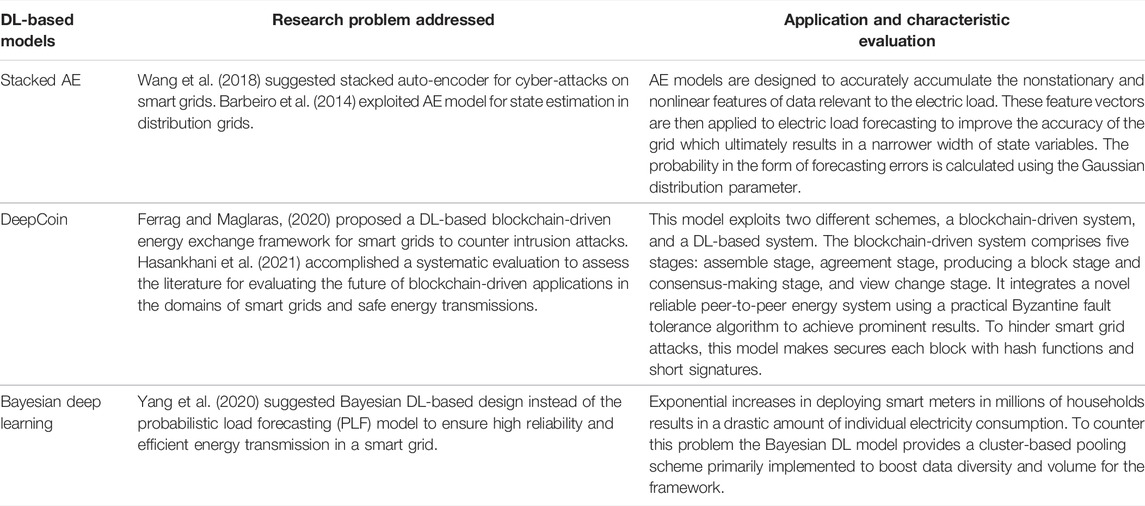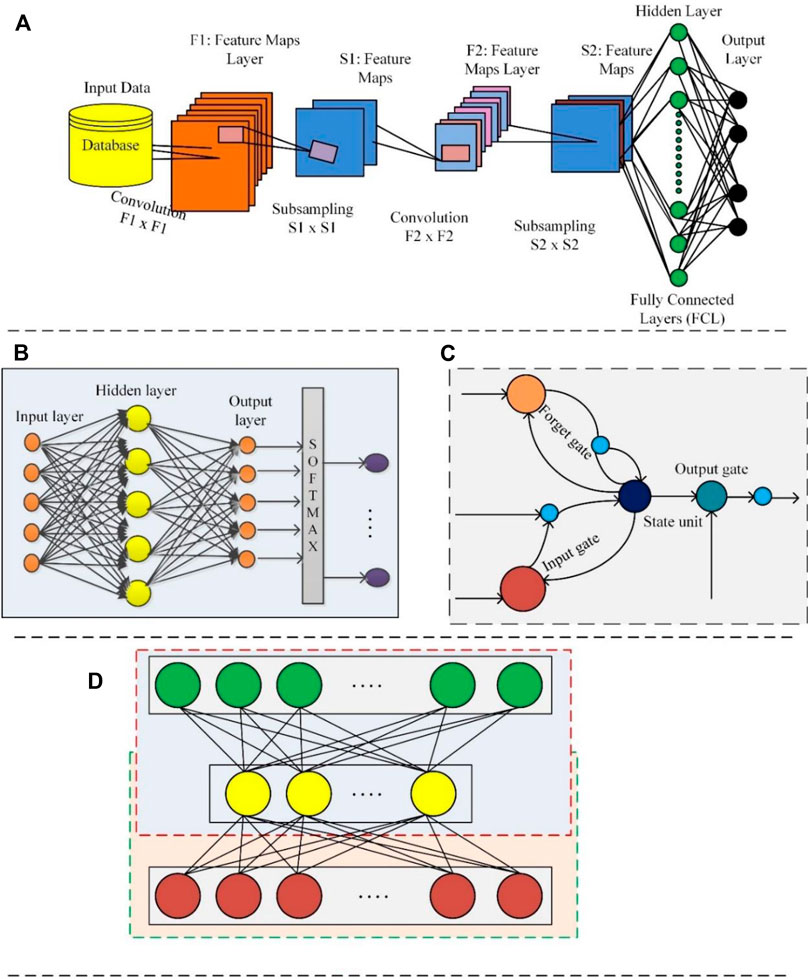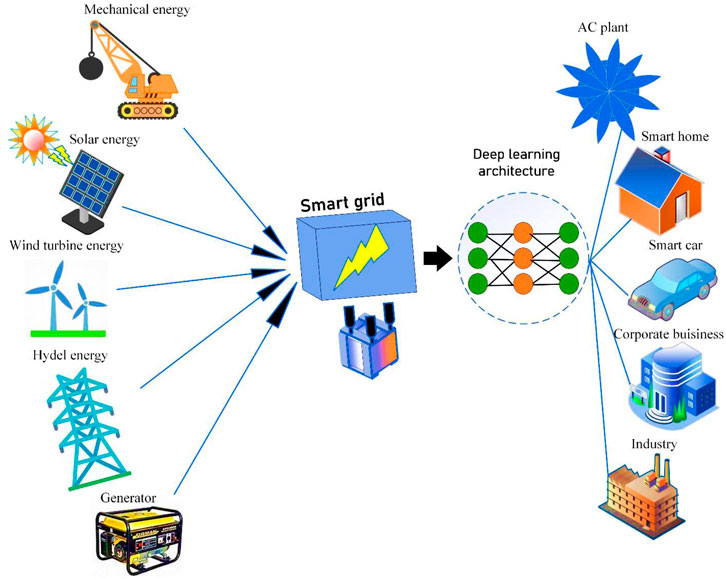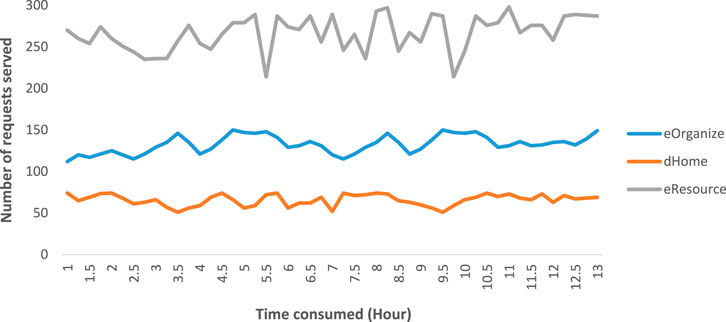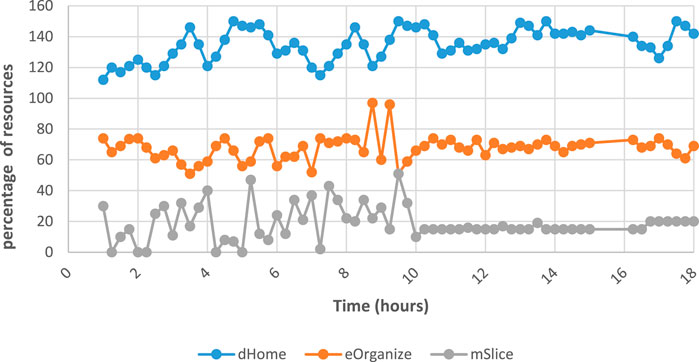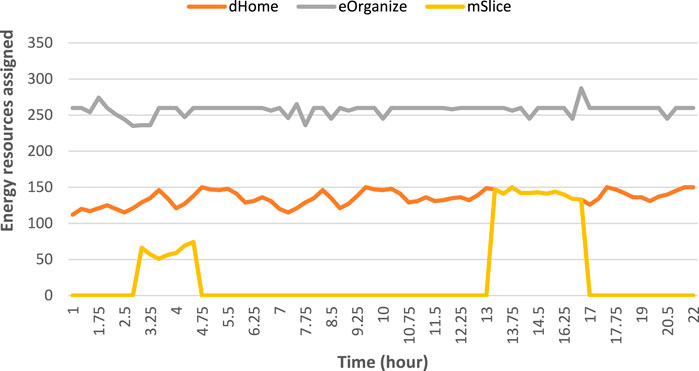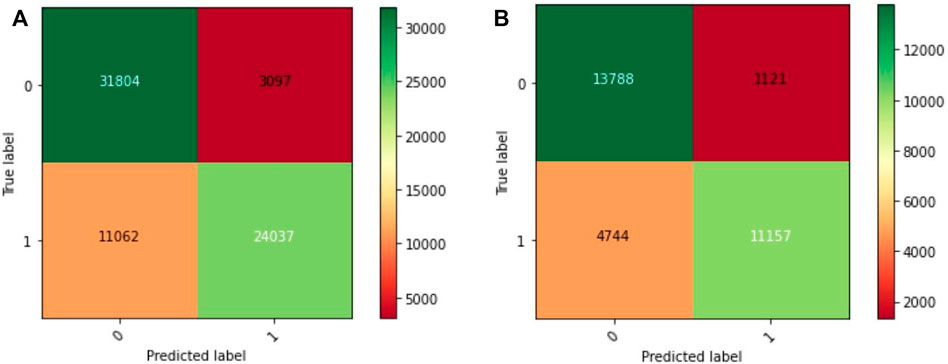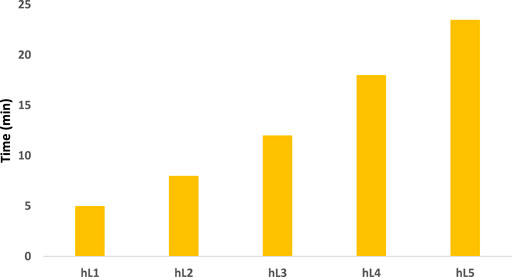- 1Department of Accounting and Information Systems, College of Business and Economics, Qatar University, Doha, Qatar
- 2Department of Computer Science, University of Swabi, Swabi, Pakistan
The over-population and the limited energy resources have puzzled the government and private organizations to think about the providence of non-stop energy resources to the industries, hospitals, smart homes, and shopping malls to ensure normal routine activities. To accept this challenge, some researchers put their efforts into generating energy from renewable energy resources (solar, fossil fuels, wind turbines, geothermal energy, and many others) to fulfill the needs of life. While some researchers worked on the efficient utilization of the available energy resources to save the energy for future generations. Inspiring from the second approach, this research work has proposed a systematic allocation of energy resources using the slice-based mechanism in a smart grid environment. This research framework using a hybrid model comprises long short-term memory (LSTM), and a support vector machine (SVM), where the LSTM classifies different energy requests (for allocation of energy resources) while the SVM accomplishes the statistical analysis (to estimate the number of solar energy resources allocated and for a specific interval of time). This need-based allocation of energy resources will not only assist in saving energy resources for future use, but will also improve the life of the power grid and other electric appliances (due to over-usage and burning). The applicability of this model is validated by testing it on a real-time scenario like slice failure conditions, slice overflow conditions, a huge number of requests, and alternate slice allocation conditions. Furthermore, the incoming request classification is also validated based on its accurate identification using a confusion matrix, varying number of hidden layers, accuracy, and time consumption. The outperformance of the selected based on these scenarios and validation metrics reflects the applicability of this framework. Moreover, this framework will assist in reducing overbilling charges and energy savage for future generations due to its need-based allocation of energy resources assignment capabilities.
1 Introduction
Globally, the rapid economic development has endowed to an exponential increase in energy demands. The snippy evolution in world economies especially in the United States, China, and Europe is bound to increase energy consumption (Bórawski et al., 2019). The energy sector is followed as the prime caryatid of excrescence, development, and keenness of enterprises and new economies (European Commission Directorate-General for Energy, 2018). Around the world, 80% of the population uses electricity as a primary source of energy. Both government and non-government organizations contribute their full efforts to ensure non-interrupted power to their customers but the over-population, exponential growth in technologies, modern-day societies, and high reliance on electricity have baffled the researcher and power suppliers, in monitoring, managing, and analyzing the power grids to ensure non-stop power flow (Tian et al., 2021). The unavailability of sufficient incentives to upgrade the transmission infrastructure for example, in the US and Europe power cuts have become more frequent (Bruch et al., 2011). Achieving high energy security and environmental protection are the primary concern of an economy focused on sustainability. The non-uniform and unbalanced distribution of electric power mostly concludes with power outages and this power outage is among the key hurdles to sustainability. The power outage is divided into two different types of short-term power failure and long-term power failure. In the first failure form, the electricity mostly lasts part of an hour or for a few hours, but the long-term blackout ensues in enduring the electricity for days or even weeks (Tian et al., 2021).
Generally, we are facing bounded energy resources with more demands. Moreover, a high budget is required to produce energy from these limited resources. Keeping in view this critical problem the research community divided into two groups with different approaches 1) to identify new energy resources to meet the customers’ needs and requirements, and 2) to efficiently utilize the available resources and develop an optimum power distribution model to provide need-based energy resources to the customers. This need-based distribution of resources not only assists in ensuring energy security and environmental protection but also improve the life of the available resources. The first group of researchers (those who decided to find alternate energy resources) presented new ideas such as Brockway et al. (2019) presented the use of fossil fuels as an alternate source of energy. They further explained that under many kismets it will remain the potent energy source to at least 2050. However, the extraction of useful energy from fossil fuels requires more energy and high incentives that resultantly make it more expensive for the customers and industrialists. Jurasz et al. (2020) accomplished a systematic analysis of the literature to perform a complementarity of the renewable energy sources. This research article provides chronological and spatial information about the extant and presented a complementarity concept of the extant. Panwar et al. (2011) and Sinsel et al. (2020) presented review articles to explain the use of renewable energy sources for environmental protection. Bórawski et al. (2019) suggested the use of biofuels as a renewable energy source for the European Union (EU). In this research article, the authors used descriptive and statistical analysis to detail the changes in bioenergy development in the EU. A. Kalogirou proposed a renewable energy source comprising solar collectors, geothermal energy, solar ponds, and photovoltaics for sea-water desalination (Kalogirou, 2005). Normally removal of salt from sea water requires high energy, so, the author presented a renewable source for sea-water desalination to bring this water into daily routine purposes like drinking, cooking, etc.
The key motivation behind the second approach (optimum utilization of the available resources) was cyber-attacks, meter reading errors, electricity theft, billing errors, fraud, and many other reasons. The unfair means and irregular distribution of the resources mostly result in providing more than enough resources to a group of people with no need, while limited energy resources to those (supposed to have more resources like industries, irrigation departments, etc.). In order to combat these challenges, some researchers like Colmenar-Santos et al. (2019) presented the concepts of smart grids to handle the issues like intermittency and the non-dispatchable nature of wind and solar energy production, but flexibility needs can migrate from generation to load, with the accretion of demand-side resources and storage technologies. A novel grid technique is suggested for the optimal integration of renewable resources and electric vehicles to increase penetration of renewable energy. Gu et al. (2020) presented a reliable fault ride mechanism to resist a large-scale disconnection of renewable energy plants due to grid faults. Lee and Lee presented an adaptive renewable energy mechanism for the base stations in the cellular networks to reduce energy consumption and provide high throughput with the help of traffic management and energy cooperation strategies (Lee and Lee, 2020). A network scheduling programming is used for the dispatching purposes between the on-grid and renewable energy resources in the base stations, while Lu et al. (2020) used stochastic programming for the optimal dispatch of on-grid and renewable energy resources. Rahbar et al. (2015) developed a real-time offline energy storage management framework for the renewable energy sources in the microgrid. Shah performed feasibility of six renewable energy sources including geothermal, municipal solid waste, biomass, wind, solar, and micro-hydro to develop a secure and renewable hydrogen-based energy source in Pakistan (Shah, 2020). The hydrogen-based energy source will enhance energy security and decrease hazardous emissions. The applicability of this renewable energy source was evaluated using Fuzzy Delphi, environmental data envelopment analysis (DEA), and fuzzy analytical hierarchy process (FAHP).
With the emergence of smart homes and integration of intelligent IoT-based smart devices, numerous automated appliances are nowadays available in every smart home architecture. These devices include a lighting system, colling and an air-conditioning system, efficient heating and ventilation system, and many others. These devices on one side make our life easier but on the other side, it requires more energy to operate and resultantly it ends up with overbilling and high costs. So, significant attention is required in terms of energy efficiency. Moreover, the energy management of the poly-generation system or micro-generation has always been very complex. Keeping the balance between demands and production is always considered as a hectic job for the research community. To combat these challenges Hadi et al. (2020) proposed an efficient demand response algorithm to resist the intermittency problem by providing a continuous power supply to the customers. Han et al. (2014) developed a smart home energy management system using ZigBee and PLC technologies. In this research article, they perform energy estimation scheduling to reduce energy costs. O’Malley et al. (2020) reviewed the multi-carrier energy systems (MCESs) for future low carbon energy systems using electrification and very high variable renewable energy penetrations. Based on their review assessments they concluded that MCESs are more efficient and flexible to deploy on a large- and small-scale network level but are more complex to control and manage. These systems are classified using strong association in computation and planning throughout multiple energy vectors and/or sectors to provide reliable, cost-effective energy services to end users/customers with minimal impact on the environment.
To meet the high climate protection and resource efficiency, the development of a sustainable smart grid design is required to present a need-based allocation of energy resources to stop the waste of energy resources. This hypothetical model contains a sliced mechanism to provide energy resources to the appliances in smart homes. This hypothetical model uses LSTM and SVM classifiers, where the LSTM performs the identification of different energy requests (devices requesting energy resources) while the SVM classifiers perform the statistical analysis to calculate the time allocation of energy resources and relieving of energy resources. Based on the energy consumption and requirements, this hypothetical model divides the appliances into different categories. It allocates energy resources based on the information including season, weather, and priority-based allocation of resources (like if it is hot then more power for the fridge, water pumps, and air conditioning system, while if it is winter then more power to heaters and other heating appliances). The rest of the study is organized by explaining the most recent and relevant research work reported in section 2 of the study. Section 3 details the hypothetical model along with a full description and algorithm. Section 4 evaluates the proposed hypothetical model based on some critical analysis followed by the conclusion and recommendations in section 5 of the study.
2 Related Work
Energy crises in the world have gained significant attention from the research community to think about the reduction of the energy resources in different areas. The abundance of integrated devices in the market and the installation of more appliances in smart homes have exponentially increased the energy consumption in the last few years (Han et al., 2014). Renewable energy sources and energy saving are alternate solutions for addressing the energy problems of smart residents. Power generation and consumption must be simultaneously considered for saving energy cost problems. The exponential increase in energy consumption, the diminution of non-renewable energy resources, the CO2 emanations resulting from energy production, and the affiliated global warming have become critical concerns worldwide, that drive the creation of new solutions for energy management and consumption. Tipantuña and Hesselbach presented an adaptive architecture for efficient energy utilization for both renewable and non-renewable energy sources (Tipantuña and Hesselbach, 2020). They suggested software-defined networking (SDN) and network functions virtualization (NFV) technologies enable and promote the primary use of energy from renewable sources. Khan et al. (2021a) proposed a smart appliances control system for the smart resident environment using the mobile application. A CNN-based hybrid solution is proposed for object identification and control purposes. Kumar et al. (2022a); Kumar et al. (2022b) suggested a hybrid model for proficient energy management using a grey wolf optimizer. Primarily, their work focuses on achieving energy from renewable energy resources and performing size optimization with reduced costs and increased productivity for the end-users.
To ensure the semipermanent development of human society, standards like energy saving and smart utilization have been encouraged by many researchers in the last few years, but above all, the need for low or zero-carbon emission sources, like renewable energy sources, have been bolstered (Int. Energy Agency Birol, 2013). Thus, green energy from renewable resources like wind and solar, in power grids has egressed as an environmentally friendly, important, and sustainable substitute to fulfill the current and future energy demands. However, the wavering nature of renewable sources due to environmental and geographical conditions may cause imbalance or instability when incorporated into the generation-consumption ecosystem (Carrasco et al., 2006). Moreover, the ineffective use of the limited energy generated has resulted in the development of different architectures such as Demand-Response (DR) systems that are capable of utilizing the available energy resources efficiently (Medina et al., 2010). This architecture comprises a set of actions and requests swapped between the energy consumer and the supplier that is accomplished using agreements, and aims to promote consumer involvement in energy management by granting the modification of consumption based on availability (Medina et al., 2010). The use of DR systems is encouraged among the consumers by offering reduced electricity bills or free-use electricity periods (Basmadjian et al., 2013; Basmadjian et al., 2018). The DR architecture can be implemented by integrating advanced ICT technology, such as data centers (Ghatikar, 2012).
Algorithms using deep learning (DL) architectures can convert simple features into more complex and abstract features automatically and are capable of solving practical problems by combining these features. Resultantly, DL has gained significant research interest in diverse domains. Since the Parousia of DL technology in 2013, DL architectures such as deep neural network (DNN) and deep belief network (DBN) have been suggested for fault diagnosing in mechanical systems. Using the recent literature as evidence, we concluded that the four DL algorithms based on CNN, DNN, Automatic Encoder (AE), and LSTM are extensively proposed in the fields of energy resource allocation and dis-connection as depicted in Table 1. The corresponding network model structures of these DNN models are shown in Figure 1.
The CNN architecture contains one or more convolutional and pooling layers, merged with a fully connected layer. These models outperformed in processing images and natural language databases, which can highly minimize the number of parameters used in the training process (Khan et al., 2019). On the other side, the CNN model is time-consuming in both the simulation and learning process. Also, its architecture is highly complicated and difficult to implement. The DNN architectures comprise at least one hidden layer trained by back-propagation and gradient descent functions. In the DNN models when we add a greater number of hidden layers it yields more abstract features that ultimately result in over-fitting problems. Auto encoder (AE) is an unsupervised training model that efficiently performs in compressing data, and thus it is often followed in data denoising and reducing visual-based data dimensions. The encouraging aspect of using the AE model is its ability to choose the suitable extended model using the actual processing data as an argument. But the capability to process only one type of data is considered the discouraging aspect of AE-based models. LSTM is a derived form of recursive neural network, capable of learning long distance dependent data. It contains multiple cells associated in series with each other, where every “cell” is framed by an input gate, an output gate, a forgetting gate, and a state unit. Strong sequence data modeling is the prominent tool of this architecture. Furthermore, the gradient fading problems can also be addressed using the output and forgetting gates. The unavailability of sufficient data (for training purposes) results in overfitting conditions and it is followed as the discouraging aspect of the LSTM models.
For achieving optimum resource utilization and traffic control, the researchers proposed sliced-based solutions for different research problems such as Khan et al. (2021b); Khan et al. (2022) suggested a sliced design for network communication systems to efficiently control the congestion and network traffic. They proposed a convolution neural network (CNN) for classification purposes, while LSTM and SVM for statistical analysis. This statistical analysis was aimed to calculate the traffic status to counter slice overflow or failure conditions. Thantharate et al. (2019) proposed a deep slice model for internet security and efficient communication in a 5th generation network. Bideh et al. (2020) suggested Message Queue Telemetry Transport (MQTT) and Constraint Application Protocol (CoAP) for calculating energy consumption to secure lightweight IoT protocols. Requeno et al. (2012) proposed a sliced model to perform phylogenetic analysis to validate the biological properties of phylogenies. After studying the literature, it was concluded that there is no sliced-based framework suggested for the efficient allocation of energy resources. To counter this problem, this research work presents a smart grid design for optimum energy resource allocation using a slice-based deep learning model. This model uses LSTM and a support vector machine (hybrid architecture), where the LSTM performs the time-based allocation of resources while SVM will perform the statistical analysis to identify the need-based allocation of energy resources. This slice-based mechanism will not assure the non-stop energy resources, but it will minimize the over-billing charges of the customers. In addition, it will have low chances to cable damage or failure of overall grids.
3 Proposed Conceptual Framework
A conceptual framework is developed in this research work for the development of a smart grid design that works by implementing a sliced-based approach to allocate energy resources to smart home appliances. The conceptual frameworks are proposed for numerous research problems like Sampaio and González proposed a conceptual design for Photovoltaic solar energy (Sampaio and González, 2017). They performed a systematic analysis by selecting different parameters like current market values, cost and technologies proposed different ways of obtaining energy resources, advantages, and disadvantages, and implications. Azar and Menassa presented a conceptual design for energy estimation in a smart building using the agent-based framework (Azar and Menassa, 2010). Chung et al. (2017) suggested a conceptual design for evaluating the security of available energy resources in South Korea. They performed a systematic evaluation of different energy resources like coal, oil, nuclear, natural gas, and renewable energy resources. They mainly focused on indexes of supply reliability, environmental sustainability, electricity production cost, and technology complementarity. Sadeq et al. (2022) presented a conceptual framework using a wireless sensor network integrated with MAC protocol (WSN-MAC) to achieve high energy consumption for the IoT devices.
Based on the literature evidence, a conceptual framework is presented in this research work for the efficient allocation of energy resources in smart homes. The proposed conceptual framework is depicted in Figure 2. Generally, this framework is divided into three main sections. The input section (incoming energy from different electrical and mechanical sources including solar panels, hydel powers, mechanical systems, generators, and other renewable energy resources), the smart grid (the overall input energy is provided to the smart grid to perform a systematic allocation of energy resources using the artificial intelligence-based design), and the different systems and devices that consume energy resources. These consumers can be of type smart homes, industries, banking systems, air-conditioning plants, universities, and many others. The artificial intelligence-based design uses a hybrid design comprising LSTM and SVM classifiers and identification models. The SVM performs the statistical analysis to identify the need for resources to accomplish a certain task. This need-based allocation of resources will not only save energy resources for future use, but also keeps different valuable appliances from burning due to overload or overuse conditions. After identifying the requirement of resources, the LSTM model calculates the timely allocation of energy resources. Also, this model is capable of assigning priority-based allocation of energy resources. For example, in hard weather conditions (summer) the priority will be assigned to the water pump and other water evacuation systems (because it is more difficult to have time without water). On the side, if it is winter, then energy resources will be assigned to those appliances that keep the room temperature constant for living beings.
In the literature, the SVM classifier is extensively suggested for the classification of linear and non-linear problems (Khan et al., 2021c). Promising results can be generated by carefully choosing the quadratic function that solely depends on the regularization parameter. Kernel-based functions are a handy tool in the regularization process. Different kernel functions like radial-based function (RBF) kernel, polynomial-based kernel, sigmoid, and linear kernels are handy tools to consider.
• Linear-based Kernel –
• Sigmoid-based Kernel –
• RBF-based Kernel –
• Polynomial Kernel –
The letters d,
where
The motivation behind the use of the SVM classifier is its easy implementation, the providence of accurate results during a limited span of time, and operationally smartness. The transformation function is implemented with the help of a non-linear operator
where
Algorithm 1. Algorithm for the proposed hybrid energy framework is mentioned below.
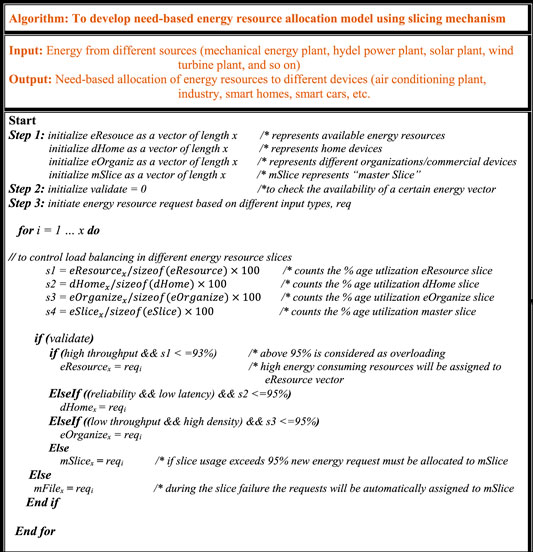 To validate the proposed conceptual model, home appliances database1 developed by the U.S. Department of Commerce is freely available for simulation and experimental work. Candanedo et al. (2017) used this database for identifying the energy use of different appliances using data-driven predictive models. They have used four different classification models including SVM with the radical kernel, multiple linear regression, random forest, and gradient boosting machines (GSM). The description of this database is detailed in Table 2. The data is accumulated for a time interval ranging from 10 min to about 4.5 months.After training and testing our model with this real-time time, the following results are generated depicted in Figure 3. It represents the number of appliances requested for energy resources and served (resources allocated during a time interval of 13 h). From Figure 3, it is concluded that sufficient resources are assigned to home appliances and commercial-based devices and there are no overloading or slice failure conditions. In other words, there are enough resources left to serve the new incoming requests.This model is validated for overloading conditions (requesting more than enough energy resources). The overloading condition is depicted in Figure 4, where the eOrganize requests for energy resources more than a slice can cover (>95%), then in this case the energy resources are automatically assigned from the reserved energy resources (mSlice) to handle any unwanted situation like overloading or slice failure conditions. The proposed model is capable of assigning mSlice to the newly incoming energy requests and also assigns the mSlice to the currently available requests as depicted in Figure 4.After overloading conditions, the automatic allocation of resources allocation is depicted in Figure 5. These results are generated for a period of 18 h. From Figure 5, it is concluded that at 9:30 and 9:45 h an overloading condition arises. When the model predicts these conditions, the new energy requests are automatically directed to mSlice (master slice) for allocation of sufficient energy requests.
To validate the proposed conceptual model, home appliances database1 developed by the U.S. Department of Commerce is freely available for simulation and experimental work. Candanedo et al. (2017) used this database for identifying the energy use of different appliances using data-driven predictive models. They have used four different classification models including SVM with the radical kernel, multiple linear regression, random forest, and gradient boosting machines (GSM). The description of this database is detailed in Table 2. The data is accumulated for a time interval ranging from 10 min to about 4.5 months.After training and testing our model with this real-time time, the following results are generated depicted in Figure 3. It represents the number of appliances requested for energy resources and served (resources allocated during a time interval of 13 h). From Figure 3, it is concluded that sufficient resources are assigned to home appliances and commercial-based devices and there are no overloading or slice failure conditions. In other words, there are enough resources left to serve the new incoming requests.This model is validated for overloading conditions (requesting more than enough energy resources). The overloading condition is depicted in Figure 4, where the eOrganize requests for energy resources more than a slice can cover (>95%), then in this case the energy resources are automatically assigned from the reserved energy resources (mSlice) to handle any unwanted situation like overloading or slice failure conditions. The proposed model is capable of assigning mSlice to the newly incoming energy requests and also assigns the mSlice to the currently available requests as depicted in Figure 4.After overloading conditions, the automatic allocation of resources allocation is depicted in Figure 5. These results are generated for a period of 18 h. From Figure 5, it is concluded that at 9:30 and 9:45 h an overloading condition arises. When the model predicts these conditions, the new energy requests are automatically directed to mSlice (master slice) for allocation of sufficient energy requests.

TABLE 2. Description of the database used for simulation purposes (Candanedo, 2017).
4 Results and Discussions
The applicability of the proposed sliced-based energy resource allocation model is validated using different scenarios and performance validation metrics. The scenarios include slice failure conditions and many energy requests. While performance metrics include accurate request identification capabilities based on precision, accuracy, and accurate time slot assignment. Moreover, the simulation time required and identification using a varying number of hidden layers are also used as evaluating strategies in this research work.
4.1 Energy Slice Failure Condition
The selected research model is assessed for the slice failure condition. The applicability of the proposed hybrid model is tested based on its accurate slice failure identification and accurate assignment of the mSlice (master slice). Based on the simulated results depicted in Figure 6, our hybrid model accurately assigned the master slice (mslice) in case of slice failure conditions.
In Figure 6, a slice failure condition occurs in the dHome slice (home appliances slice) during the period of 2 h and 15 min during the time interval 2:30 to 4:45, while another slice failure condition occurred for a period of 5 h during the interval 1:00 p.m. to 5:00 p.m. The proposed hybrid model automatically detects this slice failure condition and allocated the master slice to provide a non-stop energy resource to the ongoing requests. This automatic alternate slice allocation reflects the high applicability of this need-based energy resource allocation framework. And after slice recovery, the dHome slice is then automatically assigned back to the ongoing operations. In other words, there is no energy loss or operation loss condition occurred during this handover/slice-exchange process.
4.2 Alternate Slice Allocation
The proposed model is also validated for a high number of energy requests (utilization of an energy slice of more than 95%). In this case, the new devices from both the dHome slice and eOrganize slice are automatically routed to the mSlice. This automatic redirection assists in controlling the devices’ requests in peak hours’ conditions like the summer season (when there is more attention required for the ventilation and cooling systems).
4.3 Accurate Incoming Requests Classification
The proposed research framework is also avouched for the classification of incoming requests based on energy resources requirements (low energy resources consuming devices or high energy resources consuming devices. In other words, the incoming requests are from factories or industries (that mostly require non-stop high energy resources) or the home appliances (smart cars, smart doors, other home appliances) that typically require small energy resources. To avouch the performance of the proposed hybrid model confusion matrix, time consumption using a different number of hidden layers, precision, and accuracy are used. The experimental results are detailed below.
Figure 7 depicts the identification rate of the proposed framework using a confusion matrix as a validation parameter. The small false-positive values depict the applicability of the proposed model in the targeted research domain.
This framework is also evaluated using a varying number of hidden layers (hL) and corresponding time consumption. The low time consumption during the classification process depicts the applicability of the proposed hybrid framework. In our case, we used hidden layers (starting from one hidden layer). The corresponding results are depicted in Figure 8. These simulation results are generated on a core-i7 laptop. From Figure 8, it is observed that increases in hL resultantly increase the time consumption in the energy requests classification. If the proposed framework is trained using a GPU-based system, then the time consumption will be reduced to a number of seconds instead of minutes.
Applicability of the proposed hybrid model is also validated using different classification and recognition models including particle swarm optimization technique, grey wolf optimization, and convolution 1dimensional network (Conv 1D Net). For validation purposes, different performance metrics including recall, accuracy, precision, and area under the curve (AUC) are used. Based on the performance values it was concluded that our model outperformed by generating optimum classification and recognition results. During the experimental results, it was concluded that particle swarm optimization and grey wolf optimization techniques are shallow architectures. Shallow architectures performed well in binary classification problems, while failing in multi-class problems. In our case, we have a multi-class problem (including six different classes).
5 Conclusion
Globally, the actual energy consumption is more than the available current energy reservoirs. The daily-based infrastructure development with a high speed and exponential increase in world population is another prominent challenges to these available energy reservoirs. The research community, the public, and private organizations put their part by exploring new energy resources from solar, fossil fuels, wind turbines, geothermal energy, and many others to meet the current and future energy demands. But the non-planned energy distribution mechanism concludes with non-optimum results in the form of non-stop energy providence to different sectors (industries, smart homes, etc.). An efficient and need-based resource allocation framework is required for the providence of energy resources so that the misuse and waste of energy resources must be stopped. To combat this critical problem this research work presents a sliced-based energy providence mechanism using a hybrid model consisting of LSTM and SVM classifiers. This hybrid model can classify incoming energy requests and provides energy resources based on their requirements. In the sliced approach, the low and high energy consumption devices are divided into different slices. This sliced-based division assist not only helps in evaluating the incoming requests, but it also assists in estimating the currently available resources to fulfill the number of future energy requests they can serve.
The SVM classifier performs the statistical analysis to handle overloading and slice-failure conditions. Also, it ensures the timely allocation of energy resources. The applicability of this framework is analyzed using a real-time database and different slice failure conditions (alternate slice allocation during slice failure or overflow conditions). Other performance metrics include confusion matrix, accuracy, and time consumption. Based on the performance results, our framework outperformed not only in generating optimum classification results and providing need-based energy resources, but it also saves energy resources for future generations.
Data Availability Statement
The original contributions presented in the study are included in the article/Supplementary Material; further inquiries can be directed to the corresponding author.
Author Contributions
Leading the research, introduction, L. Reivew, Discussion, Analysis, HK The methodology by SK Discussion and conclusion by SN.
Funding
The publication was supported by Qatar National Library and Qatar University Internal Grant QUHI-CBE-21/22-1.
Conflict of Interest
The authors declare that the research was conducted in the absence of any commercial or financial relationships that could be construed as a potential conflict of interest.
Publisher’s Note
All claims expressed in this article are solely those of the authors and do not necessarily represent those of their affiliated organizations, or those of the publisher, the editors, and the reviewers. Any product that may be evaluated in this article, or claim that may be made by its manufacturer, is not guaranteed or endorsed by the publisher.
Footnotes
1https://archive.ics.uci.edu/ml/datasets/Appliances+energy+prediction
References
Azar, E., and Menassa, C. (2010). “A Conceptual Framework to Energy Estimation in Buildings Using Agent Based Modeling,” in Proceedings of the 2010 Winter Simulation Conference, 3145–3156. doi:10.1109/wsc.2010.5679007
Barbeiro, P. N. P., Krstulovic, J., Teixeira, H., Pereira, J., Soares, F. J., and Iria, J. P. (2014). “State Estimation in Distribution Smart Grids Using Autoencoders,” in 2014 IEEE 8th International Power Engineering and Optimization Conference (PEOCO2014), 358–363.
Basmadjian, R., Botero, J. F., Giuliani, G., Hesselbach, X., Klingert, S., and De Meer, H. (2018). Making Data Centers Fit for Demand Response: Introducing GreenSDA and GreenSLA Contracts. IEEE Trans. Smart Grid 9, 3453–3464. doi:10.1109/tsg.2016.2632526
Basmadjian, R., Lovasz, G., Beck, M., Meer, H. D., Hesselbach-Serra, X., Botero, J. F., et al. (2013). “A Generic Architecture for Demand Response: The ALL4Green Approach,” in 2013 International Conference on Cloud and Green Computing, 464–471. doi:10.1109/cgc.2013.79
Bideh, P. N., Sönnerup, J., and Hell, M. (2020). “Energy Consumption for Securing Lightweight IoT Protocols,” in presented at the Proceedings of the 10th International Conference on the Internet of Things, Malmö, Sweden. doi:10.1145/3410992.3411008
Bórawski, P., Bełdycka-Bórawska, A., Szymańska, E. J., Jankowski, K. J., Dubis, B., and Dunn, J. W. (2019). Development of Renewable Energy Sources Market and Biofuels in the European Union. J. Clean. Prod. 228, 467–484. doi:10.1016/j.jclepro.2019.04.242
Brockway, P. E., Owen, A., Brand-Correa, L. I., and Hardt, L. (2019). Estimation of Global Final-Stage Energy-Return-On-Investment for Fossil Fuels with Comparison to Renewable Energy Sources. Nat. Energy 4, 612–621. doi:10.1038/s41560-019-0425-z
Bruch, M., Munch, V., Aichinger, M., Kuhn, M., Weymann, M., and Schmid, G. (2011). “Power Blackout Risks. Risk Management Options. Emerging Risk Initiative—Position Paper,” in CRO Forum.
Candanedo, L. (2017). Appliances Energy Prediction Data Set. UCI Machine Learning Repository. Accessed from.https://www.archive.ics.uci.edu/ml/datasets/Appliances+energy+prediction
Candanedo, L. M., Feldheim, V., and Deramaix, D. (2017). Data Driven Prediction Models of Energy Use of Appliances in a Low-Energy House. Energy Build. 140, 81–97. doi:10.1016/j.enbuild.2017.01.083
Carrasco, J. M., Franquelo, L. G., Bialasiewicz, J. T., Galvan, E., PortilloGuisado, R. C., Prats, M. A. M., et al. (2006). Power-Electronic Systems for the Grid Integration of Renewable Energy Sources: A Survey. IEEE Trans. Ind. Electron. 53, 1002–1016. doi:10.1109/tie.2006.878356
Chung, W.-S., Kim, S.-S., Moon, K.-H., Lim, C.-Y., and Yun, S.-W. (2017). A Conceptual Framework for Energy Security Evaluation of Power Sources in South Korea. Energy 137, 1066–1074. doi:10.1016/j.energy.2017.03.108
Colmenar-Santos, A., Muñoz-Gómez, A.-M., Rosales-Asensio, E., and López-Rey, Á. (2019). Electric Vehicle Charging Strategy to Support Renewable Energy Sources in Europe 2050 Low-Carbon Scenario. Energy 183, 61–74. doi:10.1016/j.energy.2019.06.118
European Commission Directorate-General for Energy (2018). EU Energy in Figures : Statistical Pocketbook 2018: Publications Office. Available at https://www.data.europa.eu/doi/10.2833/279113.
Ferrag, M. A., and Maglaras, L. (2020). DeepCoin: A Novel Deep Learning and Blockchain-Based Energy Exchange Framework for Smart Grids. IEEE Trans. Eng. Manage. 67, 1285–1297. doi:10.1109/tem.2019.2922936
Ghatikar, G. (2012). Demand Response Opportunities and Enabling Technologies for Data Centers: Findings from Field Studies. Lawrence Berkeley National Laboratory powered by California library
Gu, Y., Huang, Y., Wu, Q., Li, C., Zhao, H., and Zhan, Y. (2020). Isolation and Protection of the Motor-Generator Pair System for Fault Ride-Through of Renewable Energy Generation Systems. IEEE Access 8, 13251–13258. doi:10.1109/access.2020.2965773
Hadi, A. A., Silva, C. A. S., Hossain, E., and Challoo, R. (2020). Algorithm for Demand Response to Maximize the Penetration of Renewable Energy. IEEE Access 8, 55279–55288. doi:10.1109/access.2020.2981877
Han, J., Choi, C.-s., Park, W.-k., Lee, I., and Kim, S.-h. (2014). Smart Home Energy Management System Including Renewable Energy Based on ZigBee and PLC. IEEE Trans. Consum. Electron. 60, 198–202. doi:10.1109/tce.2014.6851994
Hasankhani, A., Mehdi Hakimi, S., Bisheh-Niasar, M., Shafie-khah, M., and Asadolahi, H. (2021). Blockchain Technology in the Future Smart Grids: A Comprehensive Review and Frameworks. Int. J. Electr. Power & Energy Syst. 129, 106811. doi:10.1016/j.ijepes.2021.106811
Int. Energy Agency, Birol, F. (2013). World Energy Outlook 2013, IEA. Available at https://www.iea.org/reports/world-energy-outlook-2013.
Jurasz, J., Canales, F. A., Kies, A., Guezgouz, M., and Beluco, A. (2020). A Review on the Complementarity of Renewable Energy Sources: Concept, Metrics, Application and Future Research Directions. Sol. Energy 195, 703–724. doi:10.1016/j.solener.2019.11.087
Kalogirou, S. (2005). Seawater Desalination Using Renewable Energy Sources. Prog. Energy Combust. Sci. 31, 242–281. doi:10.1016/j.pecs.2005.03.001
Khan, S., Ali, H., Ullah, Z., Minallah, N., Maqsood, S., and Hafeez, A. (2019). KNN and ANN-Based Recognition of Handwritten Pashto Letters Using Zoning Features.
Khan, S., Hussain, A., Nazir, S., Khan, F., Oad, A., and Alshehr, M. D. (2021a). Efficient and Reliable Hybrid Deep Learning-Enabled Model for Congestion Control in 5G/6G Networks. Comput. Commun, 31–40. doi:10.1016/j.comcom.2021.11.001
Khan, S., Khan, S., Ali, Y., Khalid, M., Ullah, Z., and Mumtaz, S. (2022). Highly Accurate and Reliable Wireless Network Slicing in 5th Generation Networks: A Hybrid Deep Learning Approach. J. Netw. Syst. Manag. 30, 29. doi:10.1007/s10922-021-09636-2
Khan, S., Nazir, S., Ullah Khan, H., and Hussain, A. (2021b). Pashto Characters Recognition Using Multi-Class Enabled Support Vector Machine. Comput. Mater. \& Contin. 67, 2831–2844. doi:10.32604/cmc.2021.015054
Khan, S., Nazir, S., and Ullah Khan, H. (2021c). Smart Object Detection and Home Appliances Control System in Smart Cities. Comput. Mater. \& Contin. 67, 895–915. doi:10.32604/cmc.2021.013878
Kumar, A., Rizwan, M., and Nangia, U. (2022). A Hybrid Optimization Technique for Proficient Energy Management in Smart Grid Environment. Int. J. Hydrogen Energy 47, 5564–5576. doi:10.1016/j.ijhydene.2021.11.188
Kumar, A., Rizwan, M., and Nangia, U. (2022). A New Approach to Design and Optimize Sizing of Hybrid Microgrids in Deregulated Electricity Environment. CSEE J. Power Energy Syst. 8, 569–579. doi:10.17775/CSEEJPES.2020.03200
Lee, H.-S., and Lee, J.-W. (2020). Adaptive Traffic Management and Energy Cooperation in Renewable-Energy-Powered Cellular Networks. IEEE Syst. J. 14, 132–143. doi:10.1109/jsyst.2018.2890281
Lu, R., Ding, T., Qin, B., Ma, J., Fang, X., and Dong, Z. (2020). Multi-Stage Stochastic Programming to Joint Economic Dispatch for Energy and Reserve with Uncertain Renewable Energy. IEEE Trans. Sustain. Energy 11, 1140–1151. doi:10.1109/tste.2019.2918269
Medina, J., Muller, N., and Roytelman, I. (2010). Demand Response and Distribution Grid Operations: Opportunities and Challenges. IEEE Trans. Smart Grid 1, 193–198. doi:10.1109/tsg.2010.2050156
O’Malley, M. J., Anwar, M. B., Heinen, S., Kober, T., McCalley, J., McPherson, M., et al. (2020). Multicarrier Energy Systems: Shaping Our Energy Future. Proc. IEEE 108, 1437–1456.
Panwar, N. L., Kaushik, S. C., and Kothari, S. (2011). Role of Renewable Energy Sources in Environmental Protection: A Review. Renew. Sustain. Energy Rev. 15, 1513–1524. doi:10.1016/j.rser.2010.11.037
Rahbar, K., Xu, J., and Zhang, R. (2015). Real-Time Energy Storage Management for Renewable Integration in Microgrid: An Off-Line Optimization Approach. IEEE Trans. Smart Grid 6, 124–134. doi:10.1109/tsg.2014.2359004
Requeno, J. I., Blanco, R., de Miguel Casado, G., and Colom, J. M. (2012). “Sliced Model Checking for Phylogenetic Analysis,” in 6th International Conference on Practical Applications of Computational Biology & Bioinformatics, Berlin, Heidelberg, 95–103. doi:10.1007/978-3-642-28839-5_11
Sadeq, A. S., Hassan, R., Sallehudin, H., Aman, A. H. M., and Ibrahim, A. H. (2022). Conceptual Framework for Future WSN-MAC Protocol to Achieve Energy Consumption Enhancement. Sensors 22, 2129. doi:10.3390/s22062129
Sampaio, P. G. V., and González, M. O. A. (2017). Photovoltaic Solar Energy: Conceptual Framework. Renew. Sustain. Energy Rev. 74, 590–601. doi:10.1016/j.rser.2017.02.081
Shah, S. A. A. (2020). Feasibility Study of Renewable Energy Sources for Developing the Hydrogen Economy in Pakistan. Int. J. Hydrogen Energy 45, 15841–15854. doi:10.1016/j.ijhydene.2019.09.153
Sinsel, S. R., Riemke, R. L., and Hoffmann, V. H. (2020). Challenges and Solution Technologies for the Integration of Variable Renewable Energy Sources-A Review. Renew. Energy 145, 2271–2285. doi:10.1016/j.renene.2019.06.147
Thantharate, A., Paropkari, R., Walunj, V., and Beard, C. (2019). “DeepSlice: A Deep Learning Approach towards an Efficient and Reliable Network Slicing in 5G Networks,” in 2019 IEEE 10th Annual Ubiquitous Computing, Electronics & Mobile Communication Conference (UEMCON), 0762–0767. doi:10.1109/uemcon47517.2019.8993066
Tian, Y., Wang, Q., Guo, Z., Zhao, H., Khan, S., Mao, W., et al. (2021). A Hybrid Deep Learning and Ensemble Learning Mechanism for Damaged Power Line Detection in Smart Grids. Soft Comput. 1, 1–9. doi:10.1007/s00500-021-06482-x
Tipantuña, C., and Hesselbach, X. (2020). NFV/SDN Enabled Architecture for Efficient Adaptive Management of Renewable and Non-renewable Energy. IEEE Open J. Commun. Soc. 1, 357–380. doi:10.1109/OJCOMS.2020.2984982
Wang, H., Ruan, J., Wang, G., Zhou, B., Liu, Y., Fu, X., et al. (2018). Deep Learning-Based Interval State Estimation of AC Smart Grids against Sparse Cyber Attacks. IEEE Trans. Ind. Inf. 14, 4766–4778. doi:10.1109/tii.2018.2804669
Keywords: smart grids, power management, energy resources, sliced-based framework, systematic allocation
Citation: Khan HU, Khan S and Nazir S (2022) Efficient Power Grid Management Using Sliced-Based Mechanism for Systematic Allocation of Solar Energy Resources: A Conceptual Framework. Front. Energy Res. 10:922221. doi: 10.3389/fenrg.2022.922221
Received: 17 April 2022; Accepted: 05 May 2022;
Published: 15 June 2022.
Edited by:
Muhammad Amjad, University of Engineering and Technology, Lahore, PakistanReviewed by:
Astitva Kumar, Delhi Technological University, IndiaMuhammad Ibrahim, University of Science and Technology Beijing, China
Zia Ullah, University of Engineering and Technology, Peshawar, Pakistan
Muhammad Adil, University of Naples Parthenope, Italy
Copyright © 2022 Khan, Khan and Nazir. This is an open-access article distributed under the terms of the Creative Commons Attribution License (CC BY). The use, distribution or reproduction in other forums is permitted, provided the original author(s) and the copyright owner(s) are credited and that the original publication in this journal is cited, in accordance with accepted academic practice. No use, distribution or reproduction is permitted which does not comply with these terms.
*Correspondence: Habib Ullah Khan, aGFiaWIua2hhbkBxdS5lZHUucWE=
 Habib Ullah Khan
Habib Ullah Khan Sulaiman Khan
Sulaiman Khan Shah Nazir
Shah Nazir